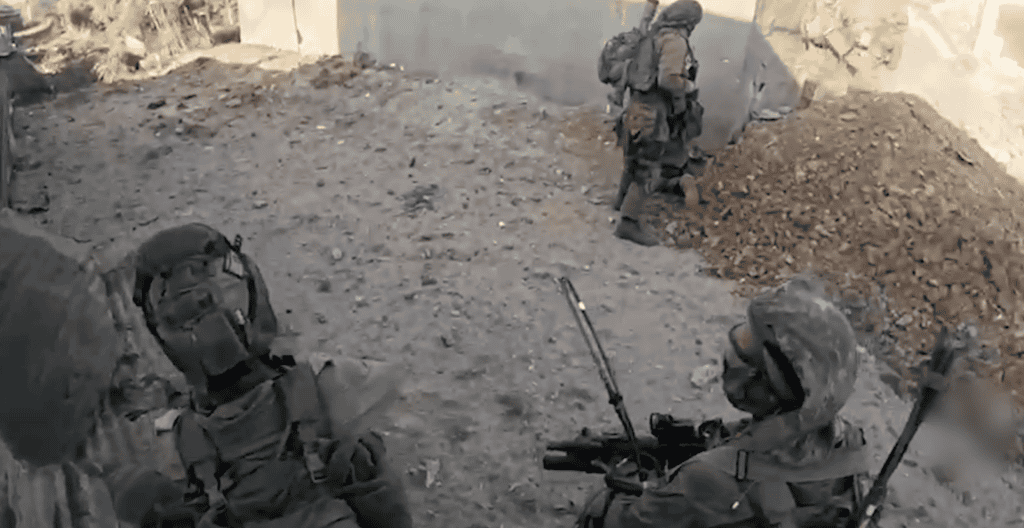
Seth Frantzman is reporting from Israel.
Israel struggled on two fronts over the weekend, trying to simultaneously pick through a densely populated Gaza while also warding off Hezbollah in northern Israel. In Gaza, the IDF paused operations during parts of the weekend to enable humanitarian evacuations. Israel Defense Forces are operating in several sectors of Gaza, in essence surrounding Gaza City itself and moving forces into various outlying neighborhoods around the city.
As IDF forces press closer to the city center, they have encountered numerous densely populated neighborhoods. Many of these neighborhoods also include hospitals. The IDF has accused Hamas of using hospitals for cover, either using the patients as human shields by having gunmen in the hospital, or by utilizing tunnels underneath and near the facilities.
For instance, the IDF said on Sunday that the commander of a Givati infantry unit “received an indication of the unusual presence of Ahmed Siam at a school in northern Gaza. It was revealed that Ahmed Siam held about a thousand residents of the Gaza Strip as hostages and human shields in the Rantisi hospital and prevented them from evacuating to the south of the Gaza Strip,” the IDF said. That incident occurred on Friday and the IDF was able to quickly process the intelligence to carry out a precision airstrike on the terrorist.
Hospitals have become a center of major international concern. The World Health Organization said they had lost communications with Al-Shifa hospital, the largest in Gaza. That hospital is located near the Mediterranean coastline west of Gaza City. To the north of Shifa is a densely populated area called Shati that grew out of a refugee camp established in 1948. South of Shifa is another hospital named Al-Quds hospital. North of Gaza City are other medical facilities also near the frontline. These include the Rantisi and Nasr hospitals and the Indonesian hospital.
Each hospital has become its own miniature crisis because of the complexity of evacuating patients. For instance, the IDF said on Sunday that it “coordinated the transfer of fuel for urgent medical use to the Shifa Hospital. Early in the morning, IDF troops arrived at the entrance of the hospital and placed 300 liters of fuel for urgent medical purposes.” At the same time, the IDF also said that it had “opened and secured a passage which enables the civilian population to evacuate, on foot and by ambulances, from the Shifa, Rantisi and Nasser hospitals.”
Fighting also continued in various neighborhoods in Gaza. This included gun battles in Shati, which is near the beach and is west of Gaza City, where the 401st armored brigade fought terrorists near the beach. This area was once an area of resorts and hotels but now churned up into a battlefield. A video released by the IDF showed operations in the area. The IDF also said that its 551st Brigade, which is made up of Israeli reserves, clashed with terrorists in Beit Hanoun north of Gaza City. Four members of the brigade were killed when a booby-trapped tunnel exploded. Their deaths were announced on Saturday. This brought total IDF casualties since Oct. 7, when Hamas launched its large attack on Israel, to 361 soldiers killed. More than 300 of them were killed on the first day of battle. Israel has revised the total death toll for the attack down from 1,400 to 1,200 killed, meaning around 800 civilians were killed in the Hamas attack on October 7.
The IDF also provided new strike numbers for the ground campaign. The campaign began on Oct. 27 and is entering its third week. “Since the beginning of ground operations in Gaza, the Air Force, with the assistance and direction of the ground forces, has struck approximately 5,000 targets in the Gaza Strip to eliminate threats in real-time. Approximately 3,300 strikes were carried out by fighter jets, 860 strikes were carried out by combat helicopters, and over 570 strikes were carried out by UAVs,” the IDF said. The new data illustrates that drone strikes constitute around ten percent of the strikes.
In northern Israel, a number of escalating incidents on Sunday increased the number of Israelis injured from attacks by Hezbollah. The IDF said seven soldiers were lightly injured by mortars targeting an area called Manara. This hill overlooks Israel’s Huleh valley and is an important hilline because it sits on the Lebanese border. In Dovev, another community on the Lebanese border around a thirty-minute drive south of Manara, anti-tank missiles were launched from Lebanon. “A number of civilians were injured as a result of the launches,” the IDF said. In each case, Israel has retaliated. A third serious incident set off sirens in cities north of Haifa.
Israeli defense officials have warned Hezbollah to stay out of the fighting in Gaza. However, Hezbollah leader Hassan Nasrallah also warned Israel and the U.S. over the weekend. He insinuated that if the U.S. did not stop the war in Gaza, Hezbollah or other members of the Iranian-backed groups in the region would continue to threaten the U.S. in Syria and Iraq. There have already been more than forty attacks on U.S. forces in Iraq and Syria. Hamas also called for international pressure to end the fighting in Gaza. Members of the Arab League and Muslim countries met in Saudi Arabia on Saturday for a joint League-Islamic conference to discuss Gaza. Although their views were divided on what to do next, the presence of the Iranian and Syrian presidents in Saudi Arabia illustrates how the conflict in Gaza has brought together countries in the region.







